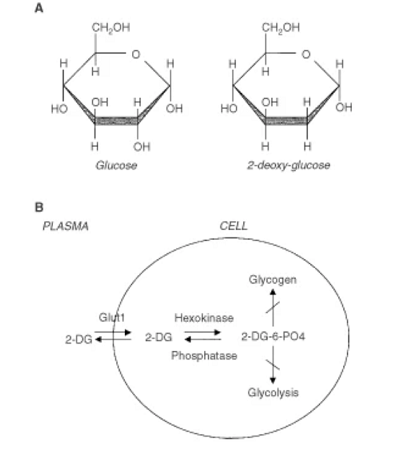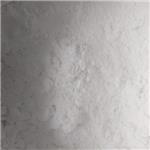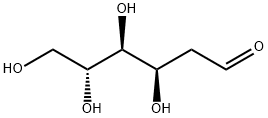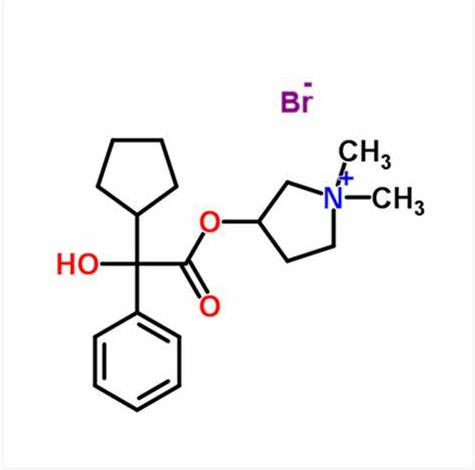2-Deoxy-D-glucose: a competitive inhibitor of glycolysis
Introduction
2-Deoxy-D-glucose (2-DG, 2-deoxy-D-arabino-hexopyranose) is a natural, nonmetabolizable glucose analogue and a competitive glycolysis inhibitor. It is a chemical analogue of glucose currently in preclinical development as a novel anticonvulsant and antiepileptic compound. 2-Deoxy-d-glucose differs from normal glucose only by removal of a single oxygen atom at the 2 position, and has been used for decades as a tracer in auto radiography and positron emission tomography (PET) imaging.
Biological function

2-deoxy-D-glucose has proved very effective in inhibiting glucose metabolism and ATP production. 2-DG undergoes facilitated diffusion into cells via glucose transporters[1]. Once intracellular, 2-DG is phosphorylated by hexokinase to 2-deoxy-D-glucose-6-phosphate (2-DG-6-P). 2-DG-6-P is not a substrate for glucose-6-phosphate dehydrogenase or phosphohexoisomerase. Therefore, 2-DG-6-P is not further metabolized once formed and will accumulate in the cell until de-phosphorylated by phosphorylase. In malignant cells, specific accumulation of 2-DG is attributed to several mechanisms: increased glucose transporter expression resulting in increased uptake, increased hexokinase activity or phosphorylating activity resulting in trapping, and low phosphorylase activity resulting in accumulation. The inhibition of glycolysis by 2-DG is thought to occur by inhibiting vital glycolytic enzymes such as phosphohexoisomerase and the depletion of high-energy compounds.
2-DG is a structural analogue of glucose differing at the second carbon atom by substituting hydrogen for a hydroxyl group. It appears to selectively accumulate in cancer cells by metabolic trapping due to increased uptake, high levels of hexokinase or phosphorylating activity, and low levels of phosphatase. Cell killing caused by 2DG has been described in several cell lines.
2-Deoxy-d-glucose is preferentially delivered to brain regions in response to energy demand by an exquisitely regulated system of neurovascular coupling involving vascular cells, perivascular neurons, and astrocytes which precisely increases regional blood flow and glucose supply within seconds and a few hundred microns in neural circuits experiencing increased activity, as occurs during seizures[2]. The anticonvulsant and antiepileptic actions of 2-deoxy-d-glucose were discovered during investigations aimed at elucidating the mechanisms underlying the ketogenic diet, a high-fat, adequate-protein, carbohydrate-restricted diet which reduces seizures by 40% and achieves complete control in 10% of drug-refractory patients. 2-Deoxy-d-glucose is currently in preclinical development for the treatment of epilepsy.
Toxicity
Toxic effects of 2-DG result from its ability to block glycosylation but not glycolysis. 2-DG could block the activity of different enzymes involved in glycolysis, leading to cell death. Hyperglycemic conditions aggravate cancer cell proliferation, inflammatory conditions, and viral infection[3]. Ketogenic Diet increases tolerance against glycolysis inhibitors. Experimental results show that 2-DG is a relatively harmless compound at low doses but can lower blood pressure and slow breathing at higher doses. Most studies indicate that a clinically tolerable dose of 2-DG is up to 63 mg/kg/day. Beyond this, several side effects are observed, including reversible hyperglycemia, gastrointestinal bleeding, and QTc prolongation. However, recent studies carried out by DRDO use a higher dose of 90 mg/kg/day. Exposure to 2-DG causes cytotoxicity and radiosensitization via a mechanism involving changes in thiol metabolism, and these effects may be more prominent in transformed vs. normal cells.
References
[1] Raman Singh. “2-Deoxy-D-Glucose: A Novel Pharmacological Agent for Killing Hypoxic Tumor Cells, Oxygen Dependence-Lowering in Covid-19, and Other Pharmacological Activities.” Advances in Pharmacological and Pharmaceutical Sciences 2023 (2023): 9993386.
[2] R L Aft, D Gius, F W Zhang. “Evaluation of 2-deoxy-D-glucose as a chemotherapeutic agent: mechanism of cell death.” British Journal of Cancer 87 7 (2002): 805–812.
[3] Meir Bialer . “Progress report on new antiepileptic drugs: A summary of the Tenth Eilat Conference (EILAT X).” Epilepsy Research 92 2 (2010): Pages 89-124.
You may like
Related articles And Qustion
See also
Lastest Price from 2-Deoxy-D-glucose manufacturers

US $10.00/Bag2025-11-11
- CAS:
- 154-17-6
- Min. Order:
- 1Bag
- Purity:
- 99.9%
- Supply Ability:
- 10kgs

US $690.00/g2025-06-01
- CAS:
- 154-17-6
- Min. Order:
- 1g
- Purity:
- 99 %
- Supply Ability:
- 5000 Kg



